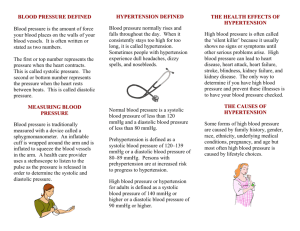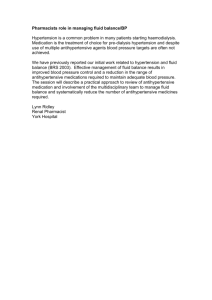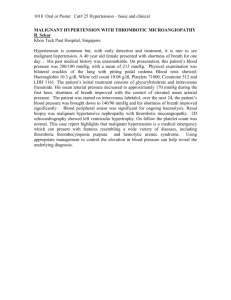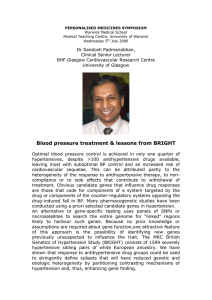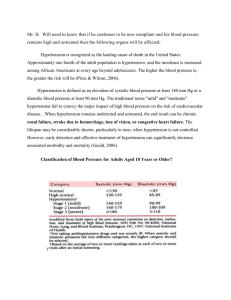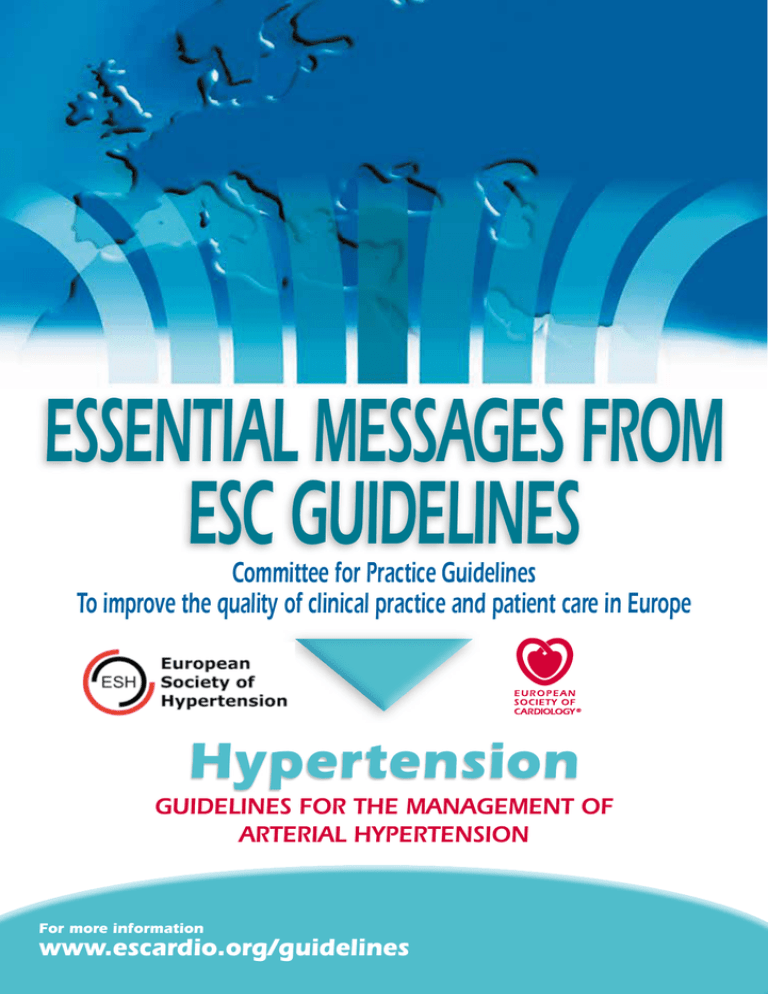
ESSENTIAL MESSAGES FROM
ESC GUIDELINES
Committee for Practice Guidelines
To improve the quality of clinical practice and patient care in Europe
Hypertension
Guidelines for the management of
arterial hypertension
For more information
www.escardio.org/guidelines
2013 ESH/ESC Guidelines
for the management
of arterial hypertension*
The Task Force for the management of arterial hypertension of
the European Society of Hypertension (ESH)
and of the European Society of Cardiology (ESC)
Chairperson ESC
Professor Robert Fagard
Hypertension & Cardiovascular
Rehabilitation Unit
KU Leuven University
Herestraat 49
3000 Leuven, Belgium
Tel: +32 16 348 707
Fax: +32 16 343 766
Email: robert.fagard@uzleuven.be
Chairperson ESH
Professor Giuseppe Mancia
Centro di Fisiologia Clinica
e Ipertensione
Via F. Sforza, 35
20121 Milano, Italy
Tel: +39 039 233 3357
Fax: +39 039 322 274
Email: giuseppe.mancia@unimib.it
Authors/Task Force Members
Krzysztof Narkiewicz (Section coordinator) (Poland), Josep Redon (Section coordinator)
(Spain), Alberto Zanchetti (Section coordinator) (Italy), Michael Böhm (Germany), Thierry
Christiaens (Belgium), Renata Cifkova, (Czech Republic), Guy De Backer (Belgium), Anna
Dominiczak (UK), Maurizio Galderisi (Italy), Diederick E. Grobbee (Netherlands), Tiny
Jaarsma (Sweden), Paulus Kirchhof (Germany/UK), Sverre E. Kjeldsen (Norway), Stéphane
Laurent (France), Athanasios J. Manolis (Greece), Peter M. Nilsson (Sweden), Luis Miguel
Ruilope (Spain), Roland E. Schmieder (Germany), Per Anton Sirnes (Norway), Peter Sleight
(UK), Margus Viigimaa (Estonia), Bernard Waeber (Switzerland), Faiez Zannad (France)..
Other ESC entities having participated in the development of this document:
Association: Heart Failure Association (HFA), European Association of Cardiovascular Imaging (EACVI), European
Association for Cardiovascular Prevention & Rehabilitation (EACPR), European Heart Rhythm Association (EHRA).
Working Groups: Hypertension and the Heart, Cardiovascular Pharmacology and Drug Therapy.
Councils: Cardiovascular Primary Care, Cardiovascular Nursing and Allied Professions, Cardiology Practice.
ESC Staff:
Veronica Dean, Catherine Despres, Karine Villanese - Sophia Antipolis, France.
*Adapted from the ESH/ESC Guidelines for Management of Arterial Hypertension (Eur Heart J 2013;34:2159-219-doi:10.1093/
eurheartj/eht151).
ESSENTIAL MESSAGES FROM
2013 ESH/ESC Guidelines
for the management
of arterial hypertension*
Table of contents
Section 1 - Take home messages
Section 2 - Major gaps in evidence
European Heart Journal 2013;34:2159-219-doi:10.1093/eurheartj/eht151
Take home messages
1 - Total cardiovascular risk stratification
Decisions on management of the hypertensive patient depend on the initial level of total cardiovascular
(CV) risk. The stratification of total CV risk in different categories is based on BP category, CV risk
factors, asymptomatic organ damage and presence of diabetes, symptomatic CV disease or chronic
kidney disease. The classification in low, moderate, high and very risk refers to the 10-year risk of CV
mortality as defined in the 2012 Joint CVD Prevention Guidelines.
Figure 1 Stratification of total CV risk in categories of low, moderate, high and very high risk according to SBP and
DBP and prevalence of RFs, asymptomatic OD, diabetes, CKD stage or symptomatic CVD. Subjects with a high normal
office but a raised out-of-office BP (masked hypertension) have a CV risk in the hypertension range. Subjects with a high
office BP but normal out-of-office BP (white-coat hypertension), particularly if there is no diabetes, OD, CVD or CKD,
have lower risk than sustained hypertension for the same office BP.
Other risk factors,
asymptomatic organ
damage,
or disease
Blood Pressure (mmHg)
High normal
SBP 130–139
or
DBP 85–89
No other RF
Grade 1 HT
SBP 140–159
or
DBP 90–99
Grade 2 HT
SBP 160–179
or
DBP 100–109
Grade 3 HT
SBP ≥180
or
DBP ≥110
Low risk
Moderate risk
High risk
1–2 RF
Low risk
Moderate risk
Moderate to
high risk
High risk
≥3 RF
Low to
Moderate risk
Moderate to
high risk
High Risk
High risk
OD, CKD stage 3 or
diabetes
Moderate to
high risk
High risk
High risk
High to
very high risk
Symptomatic CVD, CKD
stage ≥4 or
diabetes with OD/RFs
Very high risk
Very high risk
Very high risk
Very high risk
BP = blood pressure; CV = cardiovascular; CVD = cardiovascular disease; CKD = chronic kidney disease;
DBP = diastolic blood pressure; HT = hypertension; OD = organ damage; RF = risk factor; SBP = systolic blood pressure.
Risk factors include age, male sex, smoking, dyslipidaemia, glucose intolerance, obesity and family history of premature
CVD. Asymptomatic organ damage mainly involves left ventricular hypertrophy, evidence of vascular damage and
microalbuminuria.
2 - Diagnostic evaluation
The initial evaluation of a patient with hypertension should: 1) confirm the diagnosis of hypertension;
2) detect causes of secondary hypertension; and 3) assess CV risk, organ damage, and concomitant
clinical conditions. This calls for BP measurement, medical history including family history, physical
examination, laboratory investigations, and further diagnostic tests. Some of the investigations are
needed in all patients, others only in specific patient groups.
2a. Blood pressure measurement
Office blood pressure
Conventional office BP measurement by use of a validated device is the gold standard for
screening, diagnosis and management of hypertension.
Hypertension is defined as systolic BP ≥140 mmHg and/or diastolic BP ≥90 mmHg. The diagnosis
of hypertension should be based on at least two BP measurements in the sitting position per visit
on at least two visits.
ESSENTIAL MESSAGES FROM 2013 ESH/ESC Guidelines for the management of arterial hypertension
Take home messages
Out-of-office BP
Out-of-office BP, assessed by ambulatory or home BP monitoring, is an important adjunct to office BP
measurement. The prediction of CV events is significantly better with out-of-office BP than with office
BP. Prognosis is better in white-coat hypertension than in sustained hypertension and appears to be
similar to that in true normotension. The incidence of CV events is about two times higher in masked
hypertension than in true normotension and similar to the incidence in sustained hypertension.
Cut-offs for the definition of hypertension are: 130/80 mmHg for 24-h BP, 135/85 mmHg for
daytime ambulatory BP and home BP and 120/70 mmHg for night-time BP.
Major indications for out-of-office BP are suspicion of white-coat, masked or nocturnal hypertension,
suspected hypotension, considerable variability of office BP and treatment-resistant hypertension.
2b. Cardiovascular risk factors
Total, LDL and HDL cholesterol, and fasting triglycerides and glucose are considered routine tests in
all hypertensive patients.
2c. Search for asymptomatic organ damage and symptomatic disease
Heart: an ECG is recommended in all hypertensive patients; additional tests (echocardiography,
exercise testing, Holter monitoring) should be considered based on history, physical examination
and ECG findings.
Arteries: carotid and peripheral ultrasound, pulse wave velocity and ankle-brachial index should be
considered as additional tests if indicated.
Kidney: measurement of serum creatinine and estimation of glomerular filtration rate, assessment of
urinary protein and microalbuminuria are recommended in all hypertensive patients.
2d. Search for secondary hypertension.
All patients should undergo simple screening tests for secondary hypertension, including clinical
history, physical examination and laboratory investigations, and a focused search should be
undertaken when indicated.
3 - Treatment approach
3a. Lifestyle changes
Appropriate lifestyle changes are the cornerstone for the prevention of hypertension and are also
important for its treatment. The following lifestyle measures are recommended:
• Salt restriction to 5-6 g/day.
• Moderation of alcohol consumption (<20-30 g of ethanol per day in men and <10-20 g
in women).
• Increased consumption of vegetables, fruits and low-fat dairy products.
• Reduction of weight to BMI of 25 kg/m2.
• Regular exercise (≥30 min of moderate dynamic exercise on 5-7 days per week)
• Smoking cessation
ESSENTIAL MESSAGES FROM 2013 ESH/ESC Guidelines for the management of arterial hypertension
Take home messages
3b. Initiation of antihypertensive drug treatment.
Prompt initiation of antihypertensive drugs is recommended in patients at high or very high CV risk.
Antihypertensive drugs should be considered in patients at moderate or low risk when BP
remains >140/90 mmHg after, respectively, several weeks or months of appropriate lifestyle
measures, or in case of persistently elevated out-of-office BP.
In elderly patients drug treatment is recommended when systolic BP is ≥160 mmHg, or ≥140 mmHg
if younger than 80 years and treatment is well tolerated.
It is not recommended to initiate antihypertensive treatment at high normal BP and in younger
patients with isolated systolic hypertension.
3c. Blood pressure goals
Systolic BP
A systolic BP goal of <140 mmHg is recommended in all hypertensive patients, with few exceptions.
In elderly hypertensive patients less than 80 years old there is solid evidence to reduce systolic BP
to between 150 and 140 mmHg, but a goal of <140 mmHg may be considered in fit elderly.
In individuals older than 80 years it is recommended to reduce BP to between 150 and 140 mmHg
if they are in good physical and mental condition.
Diastolic BP
A diastolic BP of <90 mmHg is always recommended, except in patients with diabetes, in whom
values <85 mmHg are recommended.
3d. Choice of antihypertensive drugs
Diuretics, beta-blockers, calcium antagonists, ACE-inhibitors and angiotensin receptor blockers are
all suitable for the initiation and maintenance of antihypertensive treatment, either as monotherapy
or in combination therapy. Some agents should be considered as the preferential choice in specific
conditions, such as coronary heart disease, heart failure, diabetes or renal dysfunction.
Initiation of antihypertensive therapy with two-drug combination may be considered in patients
with markedly high baseline BP of at high CV risk. Among the many possible combinations, some
are considered more suitable than others.
4 - Treatment strategies in special conditions
4a. White-coat and masked hypertension
In white-coat hypertensives without additional risk factors, therapeutic intervention is limited to
lifestyle changes and close follow-up is warranted. In case of higher CV risk, antihypertensive drug
treatment may be considered.
In masked hypertension, both lifestyle measures and drug treatment should be considered because
of the high CV risk.
4b. Elderly
When antihypertensive therapy is indicated as described in section 3b, all antihypertensive agents can
be used, although diuretics and calcium antagonists may be preferred in isolated systolic
hypertension.
ESSENTIAL MESSAGES FROM 2013 ESH/ESC Guidelines for the management of arterial hypertension
Take home messages
4c. Pregnancy
Drug treatment is recommended in severe hypertension in pregnancy (BP >160/110 mmHg), and
may be considered in case of persistent BP ≥150/95 mmHg, and in those with BP ≥140/90 mmHg in
the presence of gestational hypertension, asymptomatic organ damage or symptoms.
Methyldopa, labetalol and nifedipine should be considered preferential antihypertensive drugs
in pregnancy. Blockers of the renin-angiotensin system should be avoided in women with
child-bearing potential.
4d. Diabetes
It is recommended to start drug treatment when systolic BP is ≥140 mmHg. The BP target
is <140/85 mmHg. All classes of antihypertensive drugs can be used, though blockers of the
renin-angiotensin system may be preferred, especially in the presence of proteinuria or
microalbuminuria, but simultaneous administration of two blockers of the renin-angiotensin system
should be avoided.
4e. Nephropathy
It is recommended to start drug treatment when systolic BP is ≥140 mmHg, targeting <140 mmHg.
A target of <130 mmHg may be considered in case of overt proteinuria, and blockers of the
renin- angiotensin system (though not in combination) are indicated in the presence of proteinuria
or microalbuminuria.
4f. Cerebrovascular disease
It is not recommended to intervene with BP-lowering therapy during the first week after acute
stroke, although clinical judgement should be used in the face of very high systolic BP values.
Antihypertensive treatment is recommended in hypertensive patients with a history of stroke or
TIA when systolic BP is ≥140 mmHg, targeting <140 mmHg. All drug regimens are recommended
in these patients, provided that BP is effectively reduced.
4g. Heart disease
Coronary heart disease
It is recommended to start drug treatment when systolic BP is ≥140 mmHg, and all antihypertensive
agents can be used, targeting <140 mmHg. Beta-blockers are recommended in case of recent
myocardial infarction, and beta-blockers and calcium antagonists in patients with angina pectoris.
Heart failure
Diuretics, beta-blockers, ACE-inhibitors, angiotensin receptor blockers and/or mineralocorticoid
receptor antagonists are recommended in patients with heart failure or severe left ventricular
dysfunction. There is no evidence that antihypertensive therapy per se or any particular drug is
beneficial in case of preserved ejection fraction. Lowering of systolic BP to around 140 mmHg
should be considered in all of these patients.
Left ventricular hypertrophy
Antihypertensive therapy is recommended, and initiation with one of the agents that have shown
greater ability to regress left ventricular hypertrophy should be considered, i.e. ACE-inhibitors,
angiotensin receptor blockers and calcium antagonists.
ESSENTIAL MESSAGES FROM 2013 ESH/ESC Guidelines for the management of arterial hypertension
Take home messages
4h. Resistant hypertension
In case of true treatment-resistant hypertension, addition of a mineralocorticoid receptor antagonist,
amiloride, and/or the alpha-blocker doxazocin should be considered. In case of ineffectiveness of
drug treatment invasive procedures such as renal denervation and baroreceptor stimulation may
be considered.
5 - Treatment of associated risk factors
It is recommended to use statin therapy in hypertensive patients at moderate to high CV risk,
targeting an LDL cholesterol value <3.0 mmol/L (115 mg/dL). When overt CHD is present,
it is recommended to administer statin therapy to achieve LDL cholesterol levels <1.8 mmol/L
(70 mg/dL).
Antiplatelet therapy, in particular low-dose aspirin, is recommended in hypertensive patients with
previous CV events. Aspirin should also be considered in hypertensive patients with reduced renal
function or at high CV risk, provided that BP is well controlled. Aspirin is not recommended for CV
prevention in low-moderate risk hypertensive patients, in whom absolute benefit and harm are
equivalent.
In hypertensive patients with diabetes, a HbA1c target of <7.0% is recommended with antidiabetic
treatment. In more fragile elderly patients with a longer diabetes duration, more comorbidities and
at high risk, treatment to a HbA1c target of <7.5–8.0% should be considered.
6 - Follow-up and improvement of blood pressure control
Individuals with high normal BP or white-coat hypertension, even in untreated, should be scheduled
for regular follow-up, at least annually, to measure office and out-of-office BP, to check the CV risk
profile and to reinforce recommendations on lifestyle changes.
After initiation of antihypertensive drug therapy in patients with hypertension, the patient should
be seen at 2- to 4-week intervals to evaluate the effects on BP and to assess possible side-effects.
Once the target BP is reached, a visit interval of a few months is reasonable. Depending on the
local organization of health resources, many of the later visits may be performed by non-physician
health care workers, such as nurses. For stable patients, home BP monitoring and electronic
communication with the physician may also provide an acceptable alternative. It is advisable to
assess risk factors and asymptomatic organ damage at least every 2 years.
The finding of an uncontrolled BP should always lead to a search for the cause(s), such as poor
adherence, persistent white-coat effect or use of BP-raising substances. Appropriate actions should
be taken for better BP control, avoiding physician inertia.
ESSENTIAL MESSAGES FROM 2013 ESH/ESC Guidelines for the management of arterial hypertension
Major gaps in evidence
Based on the review of the evidence available for the 2013 ESH/ESC Guidelines on Hypertension,
it is apparent that several therapeutic issues are still open to question and would benefit from further
investigation:
•Should antihypertensive drug treatment be given to all patients with grade 1 hypertension
when their CV risk is low-to-moderate?
• Should elderly patients with a SBP between 140 and 160 mmHg be given antihypertensive drug
treatments?
•Should drug treatment be given to subjects with white-coat hypertension? Can this condition
be differentiated into patients needing or not needing treatment?
•Should antihypertensive drug treatment be started in the high normal BP range and, if so, in
which patients?
• What are the optimal office BP values (i.e. the most protective and safe) for patients to achieve
by treatment in different demographic and clinical conditions?
•Do treatment strategies based on control of out-of-office BP provide an advantage (reduced
clinical morbidity and mortality, fewer drugs, fewer side-effects) over strategies based on
conventional (office) BP control?
•What are the optimal out-of-office (home and ambulatory) BP values to be reached with
treatment and should targets be lower or higher in high risk hypertensives?
• Does central BP add to CV event prediction in untreated and treated hypertensive patients?
•Do invasive procedures for treatment of resistant hypertension compare favourably with the
best drug treatment and provide long-term BP control and reduction of morbid and fatal
events?
•Do treatment-induced changes in asymptomatic organ damage predict outcome? Which
measures­–or combinations of measures–are most valuable?
•Are lifestyle measures known to reduce BP capable of reducing morbidity and mortality in
hypertensive patients?
• Does a treatment-induced reduction of 24h BP variability add to CV protection by antihypertensive
treatment?
• Does BP reduction substantially lower CV risk in resistant hypertension?
ESSENTIAL MESSAGES FROM 2013 ESH/ESC Guidelines for the management of arterial hypertension
ESC Cardiology Clinical Practice Guidelines
& Derivative Products Available
Eheart_34_17_co
ver.qxd
12/4/13
8:11 PM
Page 1
34
17
ISSN 0195-668X
(Print)
ISSN 1522-9645
(Online)
1 May 2013
Volume 34 Numb
er 17
1 May 2013
EUROPEAN
SOCI ETY OF
CARDIOLOGY ®
MEMBER OF THE ESC JO
URNAL FAM
ILY
European Heart Journal
European
Heart Journal
Journal of the Euro
pean
Pages 1245–1312
Air pollution and
survival in ACS
LDLR receptor and
low LDL levels
Society of Cardiolog
y
HPS2-THRIVE
The Ludwi
and Cardiovascul gshafen Risk
ar Health study
Editor-in-Chief: Thom
as F. Lüscher
Deputy Editors: Berna
rd J. Gersh
Gerhard Hindricks
Ulf Landmesser
Frank Ruschitzka
William Wijns
Senior Consulting
Editors: John A. Camm
Diederick E. Grobbe
e
Tiny Jaarsma
Gerald Maurer
Patrick W. Serruy
s
Karen Sipido
Dirk van Veldhu
isen
Christian J.M. Vrints
The invisible made
visible: multi-modality
See figure legend
imaging in the evaluati
on page 1278.
on of cardiac sarcoido
sis.
www.eurheartj.org
Abridged Pocket version
Full Text Journal version
ESSENTIAL MESSAGES FROM
ESC GUIDELINES
ESC
Educational
ESC
Educational
Courses
Courses
and Webinars
Reprinted from
European Heart Journal (2010) 31, 2369-2429
doi:10.1093/eurheartj/ehq278
Committee for Practice Guidelines
To improve the quality of clinical practice and patient care in Europe
ESC
GUIDELINES
Committee for Practice Guidelines
To improve the quality of clinical practice and patient care in Europe
CLINICAL PRACTICE GUIDELINES OF
THE EUROPEAN SOCIETY OF CARDIOLOGY
Accreditation
ESC
CLINICAL PRACTICE GUIDELINES OF
THE EUROPEAN SOCIETY OF CARDIOLOGY
For more information
www.escardio.org/guidelines
For mo
more information
www.escardio.org/guidelines
ww
www
w.esca
w.esca
Smartphone and Tablet version
For more information
www.escardio.org/guidelines
For more informatio
www.escard n
io.org/guide
lines
Essential Messages
Summary Cards
Information and downloads available at:
www.escardio.org/guidelines
Slide-Sets
EUROPEAN SOCIETY OF CARDIOLOGY
2035, ROUTE DES COLLES
LES TEMPLIERS - BP 179
06903 SOPHIA ANTIPOLIS CEDEX - FRANCE
PHONE: +33 (0)4 92 94 76 00
FAX: +33 (0)4 92 94 76 01
E-mail: guidelines@escardio.org
©2013 The European Society of Cardiology
No part of these Essential Messages may be translated or reproduced in any form without written permission from the ESC.
The following material was adapted from the ESH/ESC Guidelines for Management of Arterial Hypertension
(Eur Heart J 2013;34:2159-219; doi:10.1093/eurheartj/eht151).
To read the full report as published by the European Society of Cardiology, visit our Web Site at:
www.escardio.org/guidelines
Copyright © European Society of Cardiology 2013 - All Rights Reserved.
The content of these European Society of Cardiology (ESC) Guidelines has been published for personal and educational use only.
No commercial use is authorized. No part of the ESC Guidelines may be translated or reproduced in any form without written permission
from the ESC. Permission can be obtained upon submission of a written request to ESC, Practice Guidelines Department, 2035, route des Colles - Les
Templiers - BP179 - 06903 Sophia Antipolis Cedex - France.
Disclaimer:
The ESC Guidelines represent the views of the ESC which were arrived at after careful consideration of the available evidence at the time they
were written. Health professionals are encouraged to take them fully into account when exercising their clinical judgment. The guidelines do
not, however, override the individual responsibility of health professionals to make appropriate decisions in the circumstances of the individual
patients, in consultation with that patient, and where appropriate and necessary the patient’s guardian or carer. It is also the health professional’s
responsibility to verify the rules and regulations applicable to drugs and devices at the time of prescription.
For more information
www.escardio.org/guidelines




